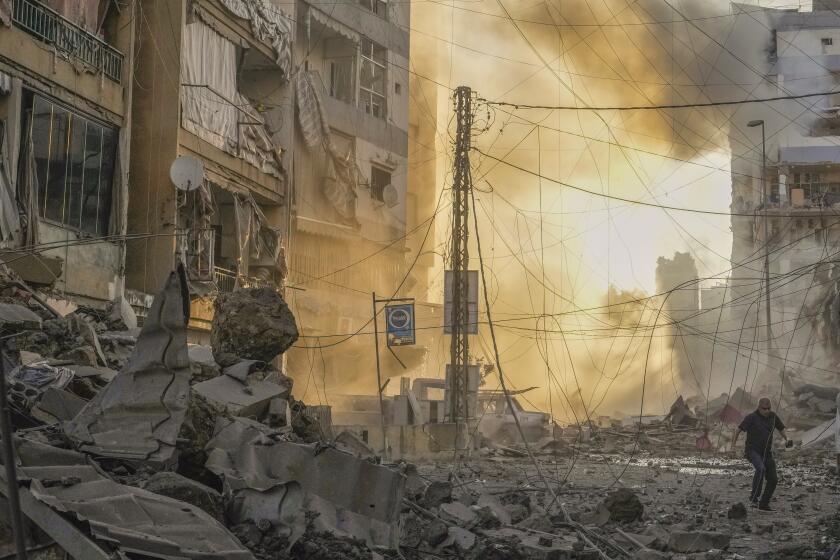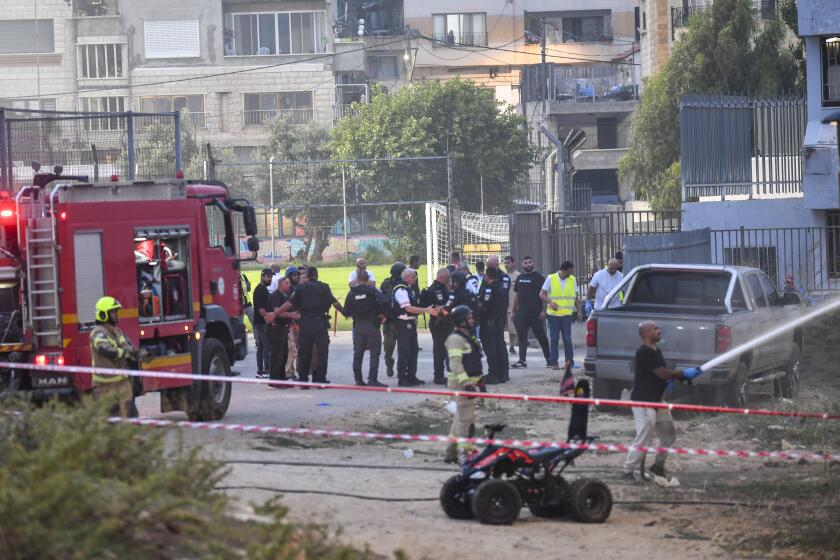Israel is building along U.N.-patrolled demilitarized zone in Syria, satellite images show

- Share via
DUBAI — Israel has begun a construction project along the so-called Alpha Line that separates the Israeli-occupied Golan Heights from Syria, apparently laying asphalt for a road right along the frontier, satellite photos analyzed by the Associated Press show.
Israeli troops have entered the demilitarized zone during the work, the United Nations confirmed to the AP, a violation of the cease-fire rules governing the area.
The work, which earlier satellite photos show began in earnest in late September, follows the completion by the Israeli military of new roads and what appears to be a buffer zone along the Gaza Strip’s frontier with Israel.
The Israel military also has begun demolishing villages in Lebanon, where United Nations peacekeepers have come under fire.
So far, there has been no major violence along the Alpha Line, which delineates the demilitarized zone between Syria and Israeli-occupied territory that U.N. peacekeepers have patrolled since 1974.
A cratered field, a mangled fence. Clues emerge from strike that killed 12 children in Golan Heights
Two days after a rocket slammed into a soccer pitch in the Israel-controlled Golan Heights, killing 12 children, many questions remain about the attack on the Druze town of Majdal Shams.
Syria, which has been at war with Israel since its founding in 1948 and relies on Iran for support, has remained silent regarding the construction.
But the Golan Heights remain a tinderbox for the two countries — making any changes along the border potentially that much more sensitive.
The Israeli military did not respond to requests for comment and Syrian officials in Damascus declined to comment.
High-resolution images taken Nov. 5 by Planet Labs PBC for the AP show over 4.6 miles of construction along the Alpha Line, starting about 1.8 miles southeast of the Israeli-held Druze town of Majdal Shams, where a July rocket strike killed 12 children playing soccer.
The images appear to show a trench between two embankments, parts of which appear to have been laid with fresh asphalt. There also appears to be fencing running along it toward the Syrian side.
Israel carried out a series of massive airstrikes Friday, hitting suburbs of Beirut and cutting off the main border crossing between Lebanon and Syria.
The construction follows a southeastern route before heading due south along the Alpha Line, and then again cutting southeast. The images show excavators and other earthmoving equipment actively digging along the route, with more asphalt piled there. The area is also believed to be littered with unexploded ordnance and mines from decades of conflict.
The United Nations maintains a peacekeeping force in the demilitarized zone called the United Nations Disengagement Observer Force.
“In recent months, UNDOF has observed construction activity being carried out by the IDF along the cease-fire line,” U.N. peacekeeping spokesperson Nick Birnback told the AP, referring to the Israel Defense Forces.
“In this regard, UNDOF has observed in some instances, IDF personnel, Israeli excavators, other construction equipment and the construction itself encroach into the area of separation.”
Birnback added that “no military forces, equipment or activity by either Israel or Syria are permitted in the area of separation.”
Israel says at least 11 people have been killed by a rocket strike in the Israeli-controlled Golan Heights. It blames Lebanon’s Hezbollah, which issues denial.
Although Israel hasn’t acknowledged the construction, it sent a 71-page letter in June to the U.N. outlining what it described as “Syrian violations of the Alpha Line and armed presence in the area of separation [that] occur daily.” The letter cited numerous Israeli-alleged violations by Syrian civilians crossing the line.
“Syrian violations of that agreement only heighten tensions in our already volatile region,” the letter added.
Syria has repeatedly accused Israel of launching attacks against it from territory it occupies in the Golan Heights. Israel has repeatedly struck Syria over the years, particularly after the start of the Mideast wars following Hamas’ Oct. 7, 2023, assault in Israel.
Syrian President Bashar Assad, who has clung to power despite his country’s long war stemming from the 2011 Arab Spring protests, criticized Israel during a summit in Saudi Arabia in which leaders discussed Israel’s wars in both the Gaza Strip and Lebanon.
“As for the tools, I believe that we possess them collectively, popularly and officially, Arabs and Muslims, countries and people,” Assad said. “What we need is the decision to use them if the Israeli entity refuses to respond. ... Without that, we are inciting the continuation of the genocide and becoming indirect partners in it.”
Israel seized control of the Golan Heights from Syria in the 1967 Mideast war. After the 1973 Yom Kippur War, the U.N. Security Council voted to create UNDOF to patrol a roughly 155-square-mile demilitarized zone and maintain the peace there. A second demarcation, known as the Bravo Line, marks the limit of where the Syrian military can operate.
President Trump on Monday signed a proclamation recognizing Israel’s sovereignty over the Golan Heights, reversing more than half a century of U.S. policy in the Middle East.
UNDOF has around 1,100 troops, mostly from Fiji, India, Kazakhstan, Nepal and Uruguay, who patrol the area.
Israel annexed the Golan Heights in 1981 — a move criticized by a U.N. resolution declaring Israel’s action “null and void and without international legal effect.” The territory, about 460 square miles in size, is a strategic high ground that overlooks both Israel and Syria.
The population consists of around 50,000 Jewish settlers and Arabs who are mostly members of the Druze sect of Shiite Islam.
In 2019, then-President Trump unilaterally announced that the United States would “fully recognize” Israel’s control of the territory, a decision that has been unchanged by the Biden administration.
Gambrell writes for the Associated Press.
More to Read
Sign up for Essential California
The most important California stories and recommendations in your inbox every morning.
You may occasionally receive promotional content from the Los Angeles Times.














